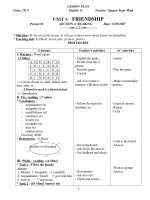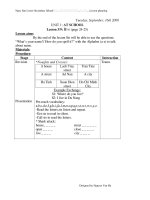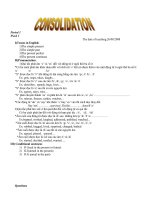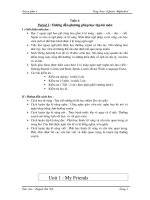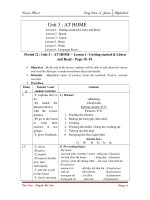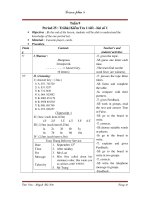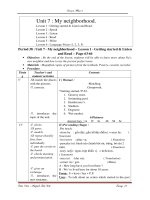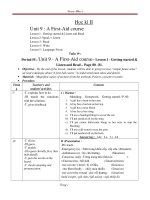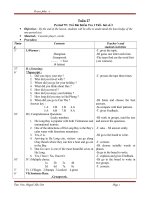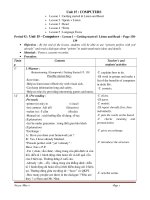LESON PLAN ENGLISH 8
Bạn đang xem bản rút gọn của tài liệu. Xem và tải ngay bản đầy đủ của tài liệu tại đây (924.28 KB, 198 trang )
Period: 1
Date: ...................
REVISION
A./ objectives:
I. Knowlege: At the end of the lesson, Ss will be able to:
- revise the basic grammatical tenses and structures they have learned in grade 7
- know some ways to learn English well.
II. Skills: writing and discussing.
B./ Method: Grammar –based approach
C. Preparation:
- T: Exercises, posters, games
- Ss: Textbook, the old knowledge
D./ procedures:
I. Settlement: Greets and checks attendance
II. Warm-up: Simon says
Commands:
- stand up - beat the table
- sit down - point your nose
- clap your hands - hands up / .................
III. New lesson:
T
/
s and Ss
/
activities Content
*) Lead-in: Chatting
?What did you do on your
summer vacation
T: introduces the task of the
lesson.
1.Act.1:
*) Answer key:
1.A 2.B 3.B 4.B 5.C
6.C 7.B 8.C 9.B 10.B
T: hangs on the exercises and
helps Ss define the language
they should use to complete
the task.
Ss: define the language in
each item.
T: asks them to work in
groups
Ss: share their ideas in
groups and then raise their
results
T: gets feedback and helps
Ss revise the structures in the
task
I. Choose the best answer from A, B and C
1. We often have Math and English......... Monday.
A. on B. at C. in
2. We are interested ..... taking part in school
activities.
A. on B. in C. at
3. How ... is it from here to your school? It
/
s 2
kilometers.
A. old B. far C. much
4............ beautiful the flowers are !
A. What B. How C. Where
5. You have a toothache. You .... go to the dentist
/
s.
A. can B. ought C. should
6. My brother is a football player. He plays it.........
A. skill B. skillful C. skillfully
7. Thomas Edison
/
s famous....... is the electric light
bulb.
A. invent B. invention C. inventing
8. Jone is ............ student in our class.
1
2. Act.2 :
T: revises Ss with the simple
present, simple past present
continuous and simple future
tense.
Ss: give structures and uses
T: asks Ss to work in groups
again to complete it.
Ss: do goupwork and speak
out their answers.
T: gets feedback and makes
the tenses more clearly
Ss: work out the tenses with
teacher.
3. Act.3.
T: writes the exercises on the
board and then instructs Ss to
define the used language.
Ss: revise the structures they
have learned.
T: asks Ss to share their
ideas in groups to complete
it.
Ss: complete them in groups
and then write their answers
on the board.
T: invites Ss to write their
sentences on the board.
Ss: correct the answers with
Teacher.
T: invites the checking and
gives feedback.
A. taller B. tallest C. the tallest
9. Ho Chi Minh city is ............ than Hue.
A. big B. bigger C. the biggest
10. The student should get used to ...... up early.
A. get B. getting C. to get
II. Use the correct tense of the verbs in parentheses.
1. At the moment, he ..... (study) animal
/
s life
2. Last year, we ....(go) to America to learn English.
3. Where are the children? They.......(play) soccer
now.
4. I think he ............(meet) us again this summer.
5. David ........(not/often/watch) TV in the morning
6. I ........(be/not) in China with my father last year.
*) Answer key:
1.is studying 2.went
3.are playing 4.will/is going to
5.doesn
/
t often watch 6.was not
III. Complete the following sentences, using the
given cues.
1. Would/like/play/chess/tonight?
- Would you like to play chess tonight?
2. You/ought/clean/room/everyday
- You ought to clean your room veryday
3. How far/it/your house/market?
- How far it is from your house to the market
4. Ho Chi Minh City/big/Viet Nam
- Ho Chi Minh City is the biggest city in Viet Nam
IV.Consolidation:
- share ideas with Ss about the ways to learn English well.
V.Homework:
- asks Ss to revise the tenses and the structures at home.
- asks Ss to prepare: Unit 1: My friends - Getting stared and listen & Read
(Page10)
2
Period: 2
Date: ...................
Unit 1: my friends
( Lesson 1: getting started and listen & read- P.10)
I. objectives:
1. Knowlege: At the end of the lesson, Ss will be able to:
- understand the content of the dialogue about Hoa
/
s friend and know how to
use “ Enough”
2. Skills: Listening, reading and speaking
II. Preparation:
- T: Pictures, posters, exercises
- Ss: Textbook, the old knowledge
III. Procedures:
I. Settlement: Greets and checks attendance
II. Warm-up: Getting started: Matching (pictures at page 10 )
- T: Shows the pictures and makes the model, and then asks Ss to work in groups
Useful language:
? How many people are there in Pic. a, b, ......
? What are they doing/?Do the girls play soccer/?Do the boys play vollayball?
- T: What is your favorite activity?/ When do you play .............? Who do you play
with?
III. New lesson:
Teacher
/
s and Ss
/
activities Content
*) Lead-in: Uses the picture in textbook
? Who are they (Hoa and Lan).
?Where are they staying (Hue)
?What are they talking about ?(Nien)
- introduces the lesson.
1.Presentation:
a.Act.1: Practice the dialogue
T: sets the scene, hangs the Qs and asks Ss
to read through them.
Ss: close the books & read through the Qs.
T: asks Ss to be about listening the
dialogue about Nien
Ss: think about the way to answer the Qs.
T: plays the tape twice.
Ss: listen and then share their answers in
pairs
T: gets feedback
Ss: speak out their answers.
T: plays the tape again
Ss: check their answers,
T: asks Ss to play the role with dialogue
Ss: read the dialogue aloud.
I. Guiding questions:
1, Was Nien Hoa
/
s classmate?
2, How old is Nien?
*)Answer:
- No, she was. She was Hoa
/
s next-door
friend.
- She is twelve
3
T: invites two pairs to practice
Ss: practice the dialogue.
2.practice:
a.Act.2: Comprehension questions
T: hangs on the task & explains the way.
Ss: read through the task
T: asks Ss to read the text again and
answer the questions in pairs
Ss: read the dialogue and share their ideas
in pairs.
T: gets feedback & checks Ss
/
understanding
Ss: speak out their answers and write them
on the board, then explain their answers.
3.Further practice:
a,Act.3: Presentation dialogue
Ts: asks the Qs: Is Hoa older than Nien?
What question tells you that?
Ss: read the dialogue again and answer the
questions
Ts: writes the model and asks Ss to repeat.
Ss: copy and read out the model.
Ts: provides another examples and checks
the meaning, form & use.
Ss: follow teacher and pick out the way to
use Enough, talk about the components in
the model sentences.
Ts: helps Ss to work out the structure
Ss: copy down.
b,Act.4: Sentence combination
T: asks Ss to work in groups and then write
their answers on the board.
Ss: share their ideas in groups and check
the results with T.
II. Ask and answer the questions
(P.11):
*) Answer key:
a, She lives in Hue
b, No, she doesn
/
t
c, She is not old enough to be in my class
d, She is going to visit Hoa at Christmas
III. Using Enough to talk about
abilities
1. Model :
Lan: Was she your classmate?
Hoa: No. She wasn
/
t old enough to be in
my class.
2. Meaning & form: We use Enough to
combine two sentences into one.
→
S+tobe+Adjective + (for someone)
+Enough + V-to-infinitive+ ...............
3.Note: For someone = for me/her/him....
IV.Use Enough to combine two
sentences into one
1,He is strong. He can carry that box
2, I am not experiences. I cannot do that
job.
3. The weather was very warm. We can go
swimming.
IV.Consolidation:
- revises Ss with the way to use Enough
- asks Ss to narrate some information about Nien, basing on the dialogue
Ex: Nien was Hoa
/
s xext-door friend in Hue. She
/
s beautiful. She was not Hoa
/
s
classmate because ..................................................
V.Homework:
- asks Ss to revise the lesson & do excercises 1- P.5 and 5-P.9 (workbook)
- asks Ss to prepare: Speak and listen-P.11-12
4
Period: 3
Date: ..........................
Unit 1: my friends ( Lesson 2: speak & listen - P.11-12)
A./ objectives:
I. Knowlege: At the end of the lesson, Ss will be able to:
- understand and practise describing their friends and someone
/
s appearance
II. Skills: Speaking ,Listening and Writing
B./ Method: Communicative approach
C. Preparation:
- T: Pictures, posters
- Ss: Textbook, new words
D./ procedures:
I. Settlement: Greets and checks attendance
II. Revision: Matching (Ss work in groups)
III. New lesson:
Teacher
/
s and Ss
/
activities Content
*)Lead-in:
“ When you want to introduce your friend to
others, What do you talk about?
? How can you describe her or his appearance
T: intrduces the lesson.
1.pre-speaking:
a)Act.1: Pre - teach
T: elicits first and says out the words
Ss: try out & repeat chorally- individually.
T: writes and checks
Ss: give the meaning & pronounciation.
T: checks vocab. : R.O.R
Ss: read and rewrite them on the board.
b)Act.2: Presentation Picture
T: shows the picture and elicits the language
Ss: answer T
/
s questions
T: asks Ss to repeat the model and then writes
the model on the board.
Ss: repeat it and copy down.
T: elicits the meaning, use, form & pro.
Ss: analize the structure, use and the position
I. Vocabulary:
- slim (Adj.). (Pict.)
- straight (Adj) (Pict.)
- curly (Adj)(Pict.)
- bold (Adj)(Pict.)
- blond (Adj) (Pict.)
- brown (Adj)(Pict.)
Language:
?How can we say her hair in English
?What color is his T-shirt trousers
II. Describe someone
/
s
appearance:
1. Model:
Lan: What does she look like?
Hoa: She is slim. She has long black
hair. She is wearing long clothes
2. Use and form : When we ask and
answer about someone
/
s appearance,
we use:
5
Tall hair clothes
Shoes short fat
T-shirt black skirt
Adjectives Nouns
- tall
- ......
- hair
- ..........
of adjectives in a noun phrase
T: focuses Ss on the position of Adj in the
noun phrase.
Ss: play the role with the model.
T: asks Ss to use the model again.
2.while-speaking
c)Act.3: Picture-cue Drill. (P. 11-12)
T: shows the pictures and runs them through
Ss: read out the phrases
T: makes the model and leads Ss
/
drilling
Ss: make the model with teacher
T: asks them to work in groups, encourages
Ss to use more language.
Ss: do groupwork, practising describing the
pictures.
T: sticks the picures and asks : What does
she/he look like?
Ss: go to the board and describe the pictures.
T: helps Ss to correct if necessary
3.post-speaking:
d,Act.4: Listening task
T: sets the scene and plays the tape twice.
Ss: listen and fill in the gaps.
T: asks Ss to share their results
Ss: work in groups & share their ideas.
T: plays the tape again
Ss: listen and check their results.
T: gets feedback.
Ss: speak out their choices.
T: plays the tape once again and help Ss to
correct their answers- predictions.
Ss: check and choose the correct ones, then
compare it with their predictions.
T: asks Ss to practise the dialogues in pairs
and then play the role orally.
Ss: read the dialogues in apirs and play the
role orally.
- What does she/he look like?
- She/he is slim/fat/thin ........ She/he
has ....
3. Notes: She has short curly blond
hair
III. Picture-cue Drill. (P. 11-12)
1. Example exchange: (Pic. a)
S1: What does she/he look like?
S2: He is tall and thin. He has short
black hair.
IV. Listen & complete the
conversations. (P.12)
*)Answer key:
1, I
/
d like to meet 4.It
/
s a pleasure to
meet you
2, Nice to meet you 5. come and
meet
3, I
/
d like to meet 6. How do you
do!
IV.Consolidation:
Guessing game;
- asks Ss to choose the picture and describe him or her. The left will listen
to him/her and guess by asking the questions: Is that Ann/........?
V.Homework:
- asks Ss to do exercise 3-P.6,7 (workbook) and write a paragragh about their father
6
- asks Ss to prepare: Read - P.13.
Period: 4
Date: ..........................
Unit1: my friends ( Lesson 4: read - Page 13)
A./ objectives:
I. Knowlege: At the end of the lesson, Ss will be able to:
- learn vocab. about character, appearance and understand the text about Ba
/
s
friends.
- talk about their friends
/
character and appearance.
II. Skills: Reading &Speaking
B./ Method: Communicative approach
C. Preparation:
- T: Pictures, posters
- Ss: Textbook, new words
D./ procedures:
I. Settlement: Greets and checks attendance
II. Check-up: - asks two Ss to write the paragragh about their father.
( homework)
- asks the whole to share their ideas.
III.New lesson:
Teacher
/
s and Ss
/
activities Content
*)Lead-in:
T: uses the picture at P. 13.
? How many people are there/?Who are
they/?What do they do/? Where do they
want to go?
T: leads in the lesson
1.pre-reading:
a)Act.1: Pre - teach
T: elicits the words from the Ss and says
them out.
Ss: try out & repeat chorally-individually
T: writes and checks.
Ss: give the meaning and stress
T: uses “ What & Where” to check vocab.
Ss: read & then rewrite the words.
b)Act.2: Open prediction
What and Where
I. Vocabulary:
- character(N)/ ................../(Example)
- sociable (adj)/ ................./ (Situation)
- kind (adj) (Trans.)
- generous(adj) /...................../ (Trans.)
- reserved (adj)/................../ (Example)
- humorous = a sense of humor
II. Predict the information:
.
7
Name Character Things he likes/enjoys
Bao
- (1) sociable
- kind
- (2) generous
- (3)doing volunteer work
Khai
- (4)reversed - (5) reading at the library
- going to school
Song
- reserved
- (6) playing soccer
- (7) going to school
Ba
-(8) humorous
Telling jokes
T: hangs on the Grids & explains the task.
Ss: follow teacher
/
s.
T: hands out the worksheets and asks Ss to
work in groups to guess the information
about Ba
/
s friends
Ss: focus the information on the Grid,
work in groups & give their answers on the
worksheets
T: gets feedback
Ss: stick their answers on th B.B
2.while-reading
c)Act.3: Read the text & check the pres.
T: asks Ss to read the text to check their
predictions.
Ss: read it in 3 Ms & pick out the
information.
T: gets feedback and gives the key
Ss: speak out their answers and check their
predictions
d)Act.4: Comprehension questions
T: hangs the questions on the poster and
asks Ss to read the text again to answer
Ss: reads it individually and then share their
ideas in pairs.
T: gets feedback.
Ss:speak the answers & write them on B.
T: helps Ss to correct and asks them to
work in pairs.
Ss: correct them , ask and answer the
questions
3.post-reading: Survey:
T: makes the model & asks Ss to work in
pairs.
Ss: ask and answer about their friends and
make the dialogue to the front.
T: explains: What is she/he like?
1. Prediction:
2. Answer key: (on the table)
III. Read and anwer the questions:
*)Answer key: (Qs - part 2-P. 14))
a, Ba feels lucky enough to have a lot of
friend
b, Bao is the most sociable person
c, Khai likes reading
d, Ba
/
s jokes annoy his friends.
e, He spends his free time doing
voluteer work at a local orphanage.
IV. Talking about your friends.
Questions:
1. What
/
s your close friend
/
s name?
2. How old is he/she?
3. What does she/he look like?
4. What is she/he like?
5. What does she/he enjoy in free time?
IV.Consolidation:
- asks Ss to talk about Ba
/
s friends, basing on the Grid.
V.Homework:
- asks Ss to write a paragragh about their friends, basing on the Qs in Post-
8
- asks Ss to prepare: Write- P.15.
Period: 5
Date: .................
Unit 1: my friends ( Lesson 5: write - Page 15)
A./ objectives:
I. Knowlege: At the end of the lesson, Ss will be able to:
- revise the language to talk about personal information and write a description
about their friends or other people.
II. Skills: Writing and speaking
B./ Method: Communicative approach
C. Preparation:
- T: Pictures, posters
- Ss: Textbook, new words
D./ procedures:
I. Settlement: Greets and checks attendance
II. Checking: Asks one student to answer some questions about their friends
? What is your friend
/
s name/ How old is she/ he?/Where does she/he like?/ What does
she/he look like?.........................................................
III. New lesson:
Teacher
/
s and Ss
/
activities Content
*)Lead-in:
T: You want to introduce or talk about your
close friend to others. What will you talk
about?
T: intrduces the tasks of the lesson.
1.pre-writing:
a)Act.1:Conprehension Questions(Part 1)
T: asks Ss to read the text and read through
the Form.
Ss: read it individually and share their ideas
about the Form in pairs.
T: elicits the used language and hangs on
the questions, explains: What is he like?
Ss: make the questions with the Form and
read through the questions.
T: asks the questions to make the model
and then asks Ss to work in pairs.
Ss: make the model with teacher and then
ask and answer the questions in pairs.
T: invites three pairs to ask and answer to
the front.
Ss: practice the laguage.
I. Read and then ask and answer:
*) Possible questions:
1, What is his name?
2, How old is he?
3,Where does he live?
4, Who does he live with?
5, What does he look like?
6, What is he like?
7, What are her best friends?
9
b)Act.2:Fill in the Form. (Part 2-P.15)
T: hangs on the Form, elicits the used
language again and makes the model.
Ss: copy it and make the questions basing
the tittle in the Form.
T: asks Ss to work in pairs, asking and
answering to fill the information of their
close friend in the Form.
Ss: ask and answer the questions (may be in
Act. 1) and fill in the information about
their friends.
T: goes round to help Ss and correct if
neccessary
Ss: work with teacher to correct
themselves.
2.while-writing:
c)Act.3: Write -It - Up
T: gives the model and asks the Ss to write
the paragragh ( 60-80 words), using the
information in their Form.
Ss: follow teacher, using their own
information to write it individually.
T: notes: Appearance, character
Ss: focus on the way to use it.
T: goes round to help Ss.
T: asks Ss to compare their daft with their
patner
Ss: compare their daft with their friends
and correct if neccessary.
3.post-writing: Exhibition
T: asks 2 Ss to go to the B.B and write the
paragraghs about their friends.
Ss: present their work on the B.B
T: asks the whole to give comments and
compare with their results.
Ss: share and compare their work.
T: asks them to correct their work.
Ss: correct with teacher.
II. Ask and answer to fill in the form
III. Write a passage to introduce a
close friend of yours.
Example:
My close friend is Tuyen. He is thirty-
two years old. He is fat and he has
short black hair....................................
IV. Share and compare:
IV.Consolidation:
- asks some Ss to go to the front of the class and introduce their close friend
with the class, using their writing task.
10
Information form
Name: Tuyen Age: 32
Appearance: Fat, short black hair
Character: Sociable, helpful
Address: 2 nguyen Du Street, Dong
Ha
Family: Mothers, father and sister
Friends: Thinh, Phong, Tuan
V.Homework:
- asks Ss to complete their paragraghs and do excercise 7-P.11 (workbook) at
home.
- asks Ss to prepare: Language Focus - P.16-17
Period: 6
Date: ......................
Unit 1: my friends ( Lesson 6: language focus- Page 16-17)
A./ objectives:
I. Knowlege: At the end of the lesson, Ss will be able to:
- Revise the simple past, simple present, present continuous tense and practise
further in Enough.
II. Skills: Writing and Speaking.
B./ Method: Communicative approach
C. Preparation:
- T: Exercises, posters.
- Ss: Textbook, the old knowledge.
D./ procedures:
I. Settlement: Greets and checks attendance.
II. warmer: Describe the picture (Picture at P. 17).
1. How many people are there in the picture?
2. What does she/he look like?
3. What is she/ he like?
4. What is she/he wearing?
(T makes the model first and helps Ss revise the present continuous, the way to
describe someone
/
s appearance, character before Ss working in groups of four)
III. New lesson:
Teacher
/
s and Ss
/
activities Content
1.Act.1:
T: asks Ss to revise the structure and the
use of simple present and simple past
tense.
Ss: give and compare two tenses, focus
on the verb form.
T: asks them to give some examples
Ss: make examples if possible.
T: instructs them to complete the
exercise and asks Ss to work in groups.
Ss: find out the context in which the
tense is used.
T: gets feedback and helps Ss to correct.
Ss: speak out their answers and explain
to the class , then correct themselves.
2. Act.2: Gap-fill
I. Use the verbs in the simple present
and simple past tense (Part1- textbook)
*) Answer key:
a: 1, lives/is living 2, sent 3, was 4, is
b: 1, are 2,come 3,showed 4,
introduced
II. use the correct form of the verbs in
11
T: checks the verbs in the box and
explains the words: planet, Mars,
Mercury, the Earth.
Ss: give the meaning of the words and
listen to teacher.
T: elicits the situation in the dialogue
and explains more about the use of
simple present.
Ss: read through the dialogue and give
their ideas.
T: asks them to complete it in groups.
Ss: share their ideas in groups.
T: gets feedback & asks the whole to
check.
Ss: write their answers and correct
them .
T: notices Ss with: Using the simple
present tense to talk about the general
truth.
Ss: note down and copy it.
3.Act.3: Using Enough.
T: gives the example and asks Ss to
combine it, using Enough.
Ss: combine it individually.
T: elicits the use and structure from Ss
first and asks Ss to compare : Enough &
Enough for someone + V-to-inf.
Ss: pick out the structure, work out the
ways and the steps to do with Enough.
T: asks Ss to combine above sentences
individually share it in pairs.
Ss: define each component, write their
own sentences.
T: gets feedback.
Ss: write their answers on the board.
T: elicits the checking from the class.
Ss: check it with teacher, give their ideas
with the complete sentences
T: explains about the way to use Enough
with Nouns
S+ tobe + Adj + ..Noun + Enough + (for
someone) + V-to-inf. + ...
Ss: copy the way to use Enough with
Nouns.
the box (Part.2- textbook)
*) Answer key:
1, sets 2,goes 3,moves
4, is 5, is 6, is
III. Combine two sentences into one
*) Example:
The table is small. I can move it
The table is small enough for me to
move it
*) Exercises:
1, The bag is big. It can carry everything.
- The bag is big enough to carry
everything.
2,Ba is old. He can drive a car.
- Ba is old enough to drive a car.
3, The table is not heavy. Nga can lift it.
- The table is not heavy for Nga to lift it.
4, Her English is good. I can understand.
- Her English is good enough for me to
understand.
5, I have some money. I can visit Ha Noi.
- I have enough money to visit Ha Noi.
12
iV.Consolidation:
- asks the Ss to revise the structure of the present continuous, the simple past
and compare it with simple present.
- asks Ss to do 10-minute examination: Write a description about their mother
(5-10 sentences)
V. Homework:
- asks Ss to revise the lesson at home.
- asks Ss to prepare: Unit 2: Getting started & Listen and Read. (P.18)
Period: 7
Date: .......................
Unit 2: making arrangements
( Lesson 1: getting started and listen & read)
A./ objectives:
I. Knowlege: At the end of the lesson, Ss will be able to:
- learn vocabulary about telecommunicative equipments and practise making
arrangements; revise “ be going to + Vbare-inf.” with the intentions.
II. Skills: Listening, reading and speaking
B./ Method: Communicative approach
C. Preparation:
- T: Pictures, posters, cassette player, tape
- Ss: Textbook, new words.
D./ procedures:
I. Settlement: Greets and checks attendance
II. Warm-up: Getting started: (Pictures at page 18 ) (Task for groupwork)
*) Answer key:
a,an answering machine d,a telephone directory
b,a mobile phone e, a public telephone
c,a fax machine f, an address book
(shows and run through the phrases; asks Ss to match the pictures with the
phrases in groups, then explain the meaning)
III. New lesson:
Teacher
/
s and Ss
/
activities Content
13
*) Lead-in: Questions:
? Do you have a telephone at home
? Do you often use it
? What do you use telephone for
- leads in the lesson
1. presentation:
a.Act.1: Pre - teach
T: elicits first and says out the words.
Ss: try out and repeat chorally- individually
T: writes and checks.
Ss: give the meaning& make sentences
T: instructs them to read & invites 2 Ss to
read all the words.
Ss: run through the words.
b.Act.2: Guiding questions
T: hangs the questions , runs them through.
Ss: read through the sentences and follow T
/
s
instructions
T: instructs them to listen to the dialogue.
Ss: listen and share their answers in pairs
T: plays the tape twice.
Ss: read the text to check their answers.
2.practice:
c.Act.3: Practise the dialogue (P.19)
T: plays the tape twice and asks Ss to listen
with closed books.
Ss: listen to the dialogue.
T: asks Ss to practise the text in pairs.
Ss: play the role in pairs.
T: invites two pairs to practise the dialogue .
Ss: read out the dialogue orally.
T: helps Ss to correct pronunciations.
Ss: check and correct themselves.
d.Act.4: Comprehension questions
T: asks Ss to read the dialogue again to
answer the Qs at P.19.
Ss: read it and answer them individually
T: gets feedback and gives feedback.
Ss: seapk out their answers and explain.
3.Further practice:
e,Act.5: Using “be + going to”
T: asks Ss to pick out the model in the text
and checks the use, form & meaning.
I. Vocabulary:
- (to) arrange (Situation)
{ arrangement(N) / .................../
EX: Nga arranged the time to see the
movie.
- downstairs # upstairs (Situation)
- (to) make the call (for someone)
(Tran.)
- (to) wait a minute (Trans.)
II. Listen and answer the
questions:
1, What time does the movie Dream
City starts?
- at 6.45
2, Is the film on at Sao Mai Movie
Theater? - Yes, it is
3, What time doNga and Hoa meet?
- at 6.30
III. Listen and practice the
dialogue:
IV. Read & answer the Qs:(P.19)
*)Answer key: Teacher
/
s book
V. Talking about the intentions in
the future.
1. Model:
14
Ss: revise the use, form & meaning.
T: instructs them to do excercise 2 (a,b,c,d)
( workbook).
Ss: share in pairs and write their answers on
the board.
T: asks the whole to check.
Ss: check the answers.
- I am going to see the movie at 6.45
this evening.
2.Form:
→
S + to be +going to + Vbare-
Infnitive..
IV. Consolidation: Mapped Dialogue
V. Homework:
- asks Ss to revise the lesson & do excercises 2,3 P.13,14 (workbook)
- asks Ss to prepare: Speak and listen -P.20,21.
Period: 8
Date: .......................
Unit 2: making arrangements
( Lesson 2: speak & listen - Page 20, 21 )
A./ objectives:
I. Knowlege: At the end of the lesson, Ss will be able to:
- practise making arrangements by telephone and revise the invitation with : Would
you like + Vto-inf............?
II. Skills: Speaking & writing
B./ Method: Communicative approach
C. Preparation:
- T: posters, Grids
- Ss: Textbook, new words.
d./ procedures:
I. Settlement: Greets and checks attendance
15
S1 S2
Hello,.............................
Hello, .......How ..............?
.....thanks. I am ........ Would
you like ..........................?
At....................................
Is ...................all right.?
........................................
Can I.................,please? This.........
.......................and you?
Yes,.......... Where ......................?
But what time ............................?
That .............. See you later, bye
II. Revision: Mapped dialogue (Consolidation in period 7)
(asks Ss to work in pairs and then make the dialogue to the front)
III. New lesson:
Teacher
/
s and Ss
/
activities Content
*)Lead-in: Questions:
? Do you often use telephone
? Do you use telephone to make
arrangements?
? What do you tell your friends about
1.pre-speaking:
a)Act.1: Ordering
T: hangs on the conversation and revises Ss
with: Can I .....?/Would you like ........?/ pop
concert.
Ss: listen to T and copy down.
Ss: work in groups , share their ideas, then
write their order on the worksheets.
T: asks Ss to guess its order in groups.
Ss: work in groups , share their ideas, then
write their order on the worksheets.
T: gets feedback and shares ideas with the
whole class.
Ss: exploit the conversation with T.
T: focuses on the form of making
arrangements.
Ss: take notes, then play the role with the
conversation..
T: invites three pairs to practice the dialogue
2.while-speaking
b)Act.2: Dialogue completion
T: sets the scene and asks Ss to read through
the dialogue first.
Ss: read it and listen to T
/
s explanations
T: elicits the language from Ss and notices:
Would you like to .....?/What about......?
Ss: give their ideas about the used language
T: asks them to work in pairs to complete the
dialogue.
Ss: work in pairs to make the dialogue and
then share their results in groups.
T: gets feedback.
Ss: play the role with their dialogues.
T: gives possible dialogues and asks Ss to
practise the dialogue again.
I. Order the conversation(Part 1-
P.20)
*) Answer key:
*) Notes:
- Can I speak to Ba, please?
May I meet
- Would you like to .....................?
II. Making arrangements to play
chess. (Part 2)
*) Possible answer:
Bao: Can I speak to Ba please? This is
Bao
Bao: I am fine, thanks. And you?
Bao: Would you like to play chess
tonight?
Bao: What about tomorrow
afternoon?
Bao: I
/
ll meet you at the Central Chess
Club.
Bao: Is 2 o
/
clock OK?
16
1
b
7
e
2
f
8
k
3
j
9
g
4
a
10
h
5
I
11
d
6
c
Ss: takes notes and build the dialogue.
3.post-speaking: Grids
T: hangs on the Form and works with Ss
about the parts of the message form.
Ss: read it through and work out the form.
T: elicits the information in the gaps.
Ss: give their ideas for each items.
T: gives the worksheets and plays the tape
twice.
Ss: listen and fill in the gaps.
T: asks Ss to share their results.
Ss: work in groups & share their ideas.
T: plays the tape again.
Ss: listen and check their results.
T: gets feedback.
Ss: speak out their answers.
T: plays the tape once again and help Ss to
correct their answers.
Ss: listen and check their information, then
compare it with their predictions.
III. Listen & fill in the information
form.
*) Answer key:
IV.Consolidation:
- notices Ss about the ways to make arrangement by telephone.
- revises Ss with the invitation: Would you like .............? and the simple future
V.Homework:
- asks Ss to complete the conversation at home
- asks Ss to prepare: Listen - P.21
Period: 9
Date: ......................
Unit 2: making arrangements
( Lesson 4: read - Page 21,22)
A./ objectives:
I. Knowlege: At the end of the lesson, Ss will be able to:
- learn vocabulary and understand the text about Alexanda Graham Bell & his
career.
- talk about him and his famous inventions
II. Skills: Reading & Speaking.
B./ Method: Communicative approach
C. Preparation:
- T: Pictures, posters, cassette player, tape
17
Kington junior high school
FOR: The Principal
DATE: Tuesday TIME:9.45
MESSAGE: Mrs. Mary Nguyen wants
to see you in the morning
TELE. NUMBER: 646 837 209 42
Kington junior high school
FOR: The principal
DATE: ............... TIME:......................
MESSAGE: ..........................................
...........................................................
TELEPHONE NUMBER: .......................
- Ss: Textbook, new words.
D./ procedures:
I. Settlement: Greets and checks attendance
II. Warmer: Hidden picture
- Teacher shows Bell
/
s picture but it is hidden with three events. Ss work in groups to
answer three questions to pick out the picture.
1. What is the biggest city in Viet Nam? (Ho Chi Minh city)
2. Where is the Great Wall? (China)
3. Where is the Twins Towel? (in Malaysia)
III. New lesson:
Teacher
/
s and Ss
/
activities Content
*)Lead-in:
T: asks Ss to look at the picture and
answer the questions.
? Who is he/ What does he do?/ Where is
he from?
Ss: answer the questions individually
1.pre-reading:
a)Act.1: Pre - teach
T: elicits the words from the Ss and says
them out.
Ss: try out & repeat chorally-
individually.
T: writes and checks.
Ss: give the meaning.
T: instructs Ss to read.
Ss: run through the words.
T: uses “Matching” to check vocab.
Ss: match the words with the
Vietnamese.
b)Act.2: Prediction
T: hangs on the poster and asks Ss to read
through the statements.
Ss: read them through and focus on the
information in statements
T: explains: patients, introduce,
demonstrate.
Ss: take notes the words.
T: asks Ss to predict T/F in groups.
Ss: work in groups & give their answers
on the worksheets & Write their answers.
2.while-reading
c)Act.3: Check the predictions.
T: asks Ss to read the text to check their
predictions.
I. Vocabulary:
- (to) emigrate /...................../ (Trans)
{ emigration (N)
Ex: Bell emigated to the USA in 1870s
- The deaf-mutes:(can
/
t speak & listen)
- ( to) experiment /................./ (Trans)
- (to) transmit speech /..................../
- (an) assistant /.................../ (Picture)
- (an) exhibition /................../ (Exam.)
Ex: Bell arranged a lot of exhibitions
II. T/F statement prediction (Part 1-
P.22)
1. Prediction:
2. Read the text & check the predictions.
*)Answer key:
18
Ss: read it in 4 Ms & pick out the
information in groups
T: gets feedback.
Ss: give their answers and explain.
d)Act.4: Ordering statements.
T: instructs Ss to choose the correct order
by reading the text.
Ss: listen to teacher
/
s instructions.
T: asks Ss to read through the statements
and then order them in groups.
Ss: read them through and read the text
to chose the correct order, then share
their ideas in groups.
T: gets feedback.
Ss: write their orders on the board.
T: invites Ss to correct the orders.
3.post-reading: Interview
T: asks the Ss to work in pairs. One is an
interviewer. The other is Bell.
Ss: practise interviewing in pairs and
then play the role to the front.
a, F b,F c,T d, F e,F f, T
III. Put events in the correct order (P,2
-P.22)
*)Answer key:
d - e- a- g - c- b- ,f
IV. Asks and answer bout Bell:
IV.Consolidation:
- asks Ss to make the coversation in interviewing.
V.Homework:
- asks Ss to read the text again at home and write the answers for “ interview”
- asks Ss to prepare: Write- P.23,24.
Period: 10
Date: ......................
Unit 2: making arrangements
( Lesson 5: write - Page 23,24)
A./ objectives:
I. Knowlege: At the end of the lesson, Ss will be able to:
- practise writing a telephone message and write the telephone message for
them
II. Skills: Writing and speaking.
19
Interviewer Bell
1. Hello. What is your name?
2. Where are you from?
3. When was you born?
4. What did you do in America?
5. When did you introduce the
telephone?
- ...........................................................
- ...........................................................
-I was born...........................................
- ...........................................................
- ...........................................................
B./ Method: Communicative approach
C. Preparation:
- T: Posters, cellophane, overhead
- Ss: Textbook, new words.
D./ procedures:
I. Settlement: Greets and checks attendance
II. Checking: Asks one student to answer the following questions:
1. Where is Bell from?
2. When was he born?
3. What did he experiment in America?
4. When did he introduce the telephone?
III. New lesson:
Teacher
/
s and Ss
/
activities Content
*)Lead-in:
T: Teacher gives the situation: a person
telephoned Mr. Tuan. But he was out. You
received the call. What will you do?
T: introduces the lesson.
1.pre-writing:
a)Act.1: Gap - fill
T: introduces the Form and helps Ss to pick
out each part.
Ss: show their ideas & give their comments
T: explains:delivery service, midday, reach
Ss: listen and remember.
T: asks Ss to complete it in groups.
Ss: share their ideas in groups
T: gets feedback & correct with the whole
class.
Ss: give the answers and get feedback.
b)Act.2: Presetation text
T: elicits the Form from Ss and then makes
it clearer.
Ss: give their ideas about making the
telephone message.
T: asks Ss to work out each part of the form
of a telepnone message.
?What will you write in the Date/Time...
Ss: share their comments with the teacher.
T: gives feedback and more explanations.
Ss: follow teacher and take notes.
2.while-writing:
c)Act.3: Grids
T: shows the Form and reads out the
passage , notices Ss with: call about,
I. Read the message to fill in the
gaps. (Part 1-P. 23)
*)Answer key:
1. telephoned 5. name
2. May 12 6. delivery
3. speak 7. Mr. Ha
4. took 8. at
II.The form of the telephone
message.
*) Form:
III. Read the passage & write a
20
Date:....................................................
Time:.....................................................
For:.......................................................
Message: .............................................
Taken by: ............................................
stationery order/take a message.
Ss: read through the form, follow T
/
s and
remember the meanings.
T: asks Ss to read the message in groups
and fill in the Form.
Ss: read it, choose the information to fill in
the telephone message in groups.
T: gets feedback and asks the whole to
share results.
Ss: speak out their results and correct it
with teacher.
b)Act.2: Write - it - up
T: introduces the situation in which Lisa
take a message for Nancy.
Ss: pay attention to the situation.
T: hands out the worksheets and asks Ss to
read the dialogue and write a telephone
message in groups.
Ss: read the dialogue then write the
telephone message for Nancy in groups.
T: goes round to help Ss.
Ss: share their ideas with teacher.
3.post-writing:
T: collects 3 drafts from Ss and put them in
the overhead.
Ss: share and compare their work.
T: helps the whole to correct.
Ss: correct their message with teacher
T: asks them to copy down.
Ss: copy it in their books
telephone passage (Part 2-P.23)
*) Answer key:
IV. Read the dialogue and write a
telephone message for Nancy (Part
3-P.23)
V.Exhibition
IV.Consolidation:
- asks the Ss to generalize the form of a telephone message & the aim of each
part.
V.Homework:
- asks Ss to complete the message at home.
- asks Ss to prepare: Language Focus - P.25,26.
Vi.supplementary notes:
Period: 11
Date: ...............................
21
Thanh cong delivery service
Date: June 16
Time: After midday
For: Mrs. Van
Message: Mr. Nam called about his
stationery order. He want you to
reach him at 8 634 082.
Taken by: Hoa
Date: Today
Time: In the morning
For: Nancy
Message: Tom wants you to play
tennis this afternoon. He will pick you
up a 1.30t
Taken by: Lan
Unit 2: making arrangements
( Lesson 6: language focus- Page 25,26.)
A./ objectives:
I. Knowlege: At the end of the lesson, Ss will be able to:
- consolidate and revise intentions with “ be going to + V-inf. ...”
- practise futher with adverbs of place.
II. Skills: Writing and Speaking
B./ Method: Communicative approach
C. Preparation:
- T: Posters, exercises
- Ss: Old gramartical items.
D./ procedures:
I. Settlement: Greets and checks attendance
II. Check-up:
- asks three student to write their telephone message that they completed at home
- asks the whole to compare and then gives marks.
III. New lesson:
Teacher
/
s and Ss
/
activities Content
1.Act.1:
T: asks Ss to think about the future
meaning and the grammatical items they
learned.
Ss: talk about the situations in which the
simple future/ be going to is used
T: gives the example: What does Nga
have?/ What does she want to?.
Ss: copy it and answer T
/
s questions.
T: elicits the model and asks Ss to read it.
Ss: rewrite it and read it chorally.
T: revises the use and form again
Ss: talk about the use, three forms.
T: asks Ss to rewrite the sentences in Part
1, using “ be going to” in pairs.
Ss: do pairwork , defining the actions and
intentions and writing the sentences.
T: gets feedback & helps Ss to correct.
Ss: speak out and write them on the board.
2.Act.2:
T: hangs the Table at P. 25 and makes the
model with Ss.
I. Rewrite the sentences, using “ be
going to “ (Part 1-P.25)
1) Model:
- Nga has a movie ticket.
She is going to see a movie
2) Structure: Talk about intentions.
(+) I + am + going to + V-
infinitive+..
She/he + is
We/You/They + are
(-) S + tobe + not + going to +
Vinf. .......
(?) Tobe + S + going to + Vinf. ..........?
3)Answer key:
a, They are going to go fishing
b, Trang is going to read a new novel.
c, Van is going to do her homework in
Math.
d, Mr. Hoang is going to see an
interesting action movie.
e, Hien is going to attend her friend
/
s
birthday party.
II. Ask and answer about what you
are going to do (Part 2-P.25).
*)Model:
S1:Are you going to see a movie?
S2: Yes, I am.
22
Ss: run through the Table and make the
model with teacher.
T: revises Ss with Y/N question with “ be
going to”
Ss: pick out the structure and the way to
answer this question.
T: asks Ss to work in groups, asks the
questions and write their friend
/
s name if
they say Yes .
Ss: go round to ask the questions and write
their friend
/
s name in their Form.
T: invites 4 Ss to report their information.
Ss: say out their information. Ex: Nga is
going to play sports on the weekend.
T: helps them to correct and then asks
them to talk about what they are going to
do on the weekend.
Ss: correct themselves and then talk about
them. Ex: I am going to do my homework
on the weekend.
3.Act.3:
T: runs through the words in the box and
sets the scene.
Ss: read them out and pay attention to the
situation.
T: checks the meaning, use of the adverbs.
Ss: give the meaning and use, talking
about its position in a sentence.
T: asks them to complete Exer.3 in pairs.
Ss: share their ideas in pairs
T: gets feedback & asks the whole to
check.
Ss: speak out their answers and check the
results with teacher.
III. Use advebs of place to complete
the sentences.(Part 3-P.26).
*)Model: Textbook-P.26
*)Answer key:
b, upstairs c, inside
d, outside e, there f, here
IV.Consolidation:
*)Act.1: Guessing game
Model sentence: I am going to........................ on the weekend.
- asks Ss to give 5 activities they are going to do
- gives the model and asks Ss to choose one activity to fill in it.
- asks Ss to guess T
/
s sentence by saying: Are you going to (see a movie) ……?
- If anyone guess it right, he/she will go to the front and others will guess her/his
sentence.
*)Act.2: asks Ss to write 5 sentences about what they are going to do. (10-m exam)
V.Homework:
23
- instructs Ss to do excercise 2,3-P.14,15,16 ( workbook) at home.
- asks Ss to prepare: Unit 3: Getting started and listen & read
Period: 12
Date: ......................
Unit 3: at home
(Lesson 1: getting started and listen & read)
A./ objectives:
I. Knowlege: At the end of the lesson, Ss will be able to:
- understand the dialogue and revise the vocabulary about chores.
- understand and use “ Have to” for oblication.
II. Skills: Listening, reading and speaking
B./ Method: Communicative approach
C. Preparation:
- T: Pictures, posters.
- Ss: Textbook, new words.
D./ procedures:
I. Settlement: Greets and checks attendance
II. Warm-up: Getting started: (Pictures at page 27 )
T: sticks 6 pictures and elicits the language from Ss
Ss: look at the pictures and try to give out the chores
T: gives the phrases and asks Ss to match them with the pictures
Ss: match them individually and then read them out.
T: gives the model: - What do you often do at home?
- I often do the washing and........................
Ss: ask and answer in pairs then do it to the front of the class.
III. New lesson:
Teacher
/
s and Ss
/
activities Content
*) Lead-in:
You often do the washing, cook..... and
today you will know the chores our friend,
Nam often does at home.
- leads in the lesson.
1. presentation:
a.Act.1: Pre - teach
T: elicits first and says out the words.
Ss: try out and repeat chorally-
individually
T: writes and checks.
Ss: give the meaning& make sentences
T: uses “ What and where” to check vocab.
Ss: read & then write the words on the B.B.
b.Act.2: Practise the dialoguge.
T: sets the scene , reads the dialogue once.
Ss: listen to teacher
I. Vocabulary:
- (the) chores (Situation)
+ I often do the chores in the morning
- (a) cupboard /................/(Picture)
- (a) steamer /.............../ (Picture)
- (a) saucepan /................./(Picture)
- (a) rice cooker (Picture)
- (a) frying pan (Picture)
II. Reading the dialogue:
24
T: asks Ss to work in pairs, practising the
dialogue.
Ss: play the role as Nam and Mrs. Vui.
T: goes round to help Ss practise it.
Ss: work with teacher
T: invites two pairs to read the dialogue
Ss: practise the dialogue orally.
2.practice:
a.Act.1: Comprehension questions.
T: writes the questions on the board & asks
Ss to read the dialogue again to answer.
Ss: read the dialogue again and share their
ideas in pairs to answer them.
T: gets feedback.
Ss: speak out their answers and then check
them with teacher.
T: asks the whole to check.
Ss: ask and answer the questions in pairs
T: invites three pairs to ask and answer
3.Further practice:
Presentation dialogue
T: asks Ss to pick out the model in the text
and checks the use, form & meaning.
Ss: read the text again and give the use,
form & meaning.
T: asks Ss to use the model.
Ss: ask and answer it in pairs.
* Notes:
-We can use Have to as the below model
Ex: She has not to stay at home
- We use Have to for the subjective
oblicaion and Must for the objective one.
III. Read and answer the questions:
Questions and answers:
1, What does Mrs. Vui have to do after
work?
- She has to go and visit her Grandma.
2, What does Nam have to do?
- He has to cook dinner, go to the
market and buy some fish and
vegetables
IV. Using “Have to” for oblication
1. Model:
S1: What does Mrs. Vui have to do after
work?
S2: She has to go & visit her Grandma.
2. Use &Form: When we talk about the
obligation, we use:
(+)S + have/has to + Vbare-inf. +.....
(-) S + don
/
t/doesn
/
t have to+Vbare-inf
(?)Do/Does + S+ have to + Vbare-inf..
IV. Consolidation: Word cue Drill (Pairwork)
1. You/do the washing 4. Nga/make the bed
2. You/sweep the floor 5. Nam/cook meals
3. She/ tidy up 6. They/feed the chicken
Example exchange: S1: What do you have to do?
S2: I have to do the washing
S1: What does she have to do?
S2: She has to tidy up
T: Shows the cards , runs them through then makes the model first.
S: read out the phrases and follow teacher
/
s model.
T: instructs Ss to practise; T Ss, Ss T ; closed pairs open pairs
V. Homework:
- asks Ss to revise the lesson & do excercises 1,2,3 P.20,21 (workbook)
25
